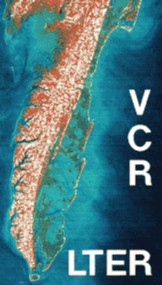 Dynamics of a metapopulation of Gull-billed Terns in Virginia |

R. Michael Erwin
Environmental Sciences
|
 Dynamics of a metapopulation of Gull-billed Terns in Virginia |

R. Michael Erwin
Environmental Sciences
|
Gull-billed Tern populations in coastal Virginia have plummeted since the mid-1970s from more than 2000 pairs ( Erwin 1979, Williams et al. 1990) to only about 500-700 over the past 5 years (Erwin, unpubl. data). Reproductive success seems to be low in virtually every colony. Little is known about the nesting ecology of this species in North America. As a result, a study began in 1994 to assess the reproductive success, colony site selection, and feeding ecology of the species at a number of study sites in coastal Virginia.
From 1994 to 1996, results suggested that nesting success on large barrier islands and on small shellpiles associated with lagoonal marsh islands was very low, with flooding being a principal cause of nest failure. Predation at some sites by great horned owls was also significant in certain times.
Because of high flooding frequency, and because barrier islands are becoming increasingly occupied by mammal predators, we initiated a "restoration" project in 1997 with USFWS funding. This enabled us to conduct an adaptive resource management study whereby shells were used to build up marsh shellpiles. By experimentally augmenting four previously used sites, and adding several control sites, we will evaluate whether the addition of 100-150 bushels of shells to increase elevations by 10-30 cm acts to attract more nesting terns. We will be monitoring the numbers of nesting pairs using each site (plus surrounding sites) and will follow hatching success. In addition, more feeding data will be collected to determine dietary changes within and among years.
Erwin, R.M. 1979. Coastal waterbird colonies: Cape Elizabeth Maine to Virginia. USFWS, OBS, FWS/OBS-79/10.
Williams, B., et al. 1990. Longitudinal surveys of the beach nesting and colonial waterbirds of the Virginia barrier islands, 1975-1988. Virginia J. of Science 41: 381-388.